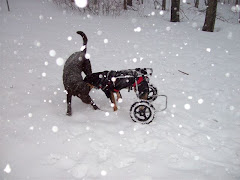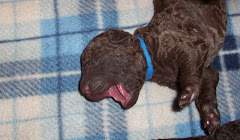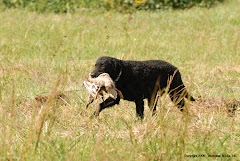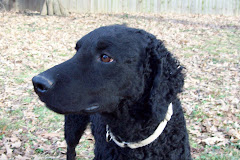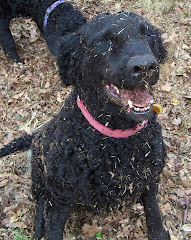I know I don't hold the monopoly for owning the 'best puppy in the world' but Singer, my curly-coated retriever, was pretty close, if you ask me. She could sit quietly in my lap for long periods of time (through a business meeting) and visit with the person sitting next to me - of course, she ended up visiting herself around the room from lap to lap and had to be collected after the meeting.
She loved field training. At 3 months of age she discovered the joys of "duck" and never looked back. She was such an avid retriever that she took one of my older dog's places when we went training (is there really an unwritten rule that when training with a group you're limited to two dogs?)
She really was a sweetie, but she did have one terrible flaw. She loved mud! This flaw first surfaced when she was a tiny pup. While walking in the park one day, she spied a mud puddle. Being on a leash, she couldn't get to it so she "ordered" me to get close. I wasn't sure what she wanted but followed her pull, snapping her back just in the nick of time when I realized she wanted to do a belly splat into it.
If you've never seen a puppy throw an all out temper tantrum, you missed it. It was so funny. We laughed at her while she wiggled, squirmed and screamed trying to reach that puddle. She pulled to the end of her leash and tried throwing herself at it. Had she been older and bigger that might have worked. The only way to distract her was to put distance between her and the puddle so we moved to dryer ground. She's never really gone for mud as an adult, thank goodness, though she has retrieved birds in some pretty scuzzy water without complaint.
Q & A for the day:
Is there really any harm in giving in to your dog?
Yes! Giving in implys that you made the concession and the dog got what it wanted. The only consistent thing about successful dog training is Consistency. If the dog ever learns that he can wait you out, you have created a larger problem. If you give a command, you must get the action requested - no exceptions. The number one booboo is calling the dog to come to you when you have no way to make sure he comes. If you are going to teach commands, you must have sufficient control of the dog to make sure he obeys the commands you give. A long leash is the best tool for teaching Come. The Golden Rule (or one of them) is "Never give a command you can't enforce".
Hunter
A true gentleman
Wednesday, February 20, 2008
Sunday, February 10, 2008
Tackling Toenails
When Hunter, the 3 year old Curly-Coated Retrievier, joined the Windsong family, he came with monster toenails. Not only were they way too long, they were also too big for the clipper that I used on Niki, the Huskyish pound puppy, and they were jet black so I couldn't see through them. In retrospect, it is probably good that the clipper was too small as I could only nip off less than 1/8 inch at the tip of the nail. Hunter let me do one, count it, ONE toenail, before he screamed and jumped and ran away. I was stupefied, but that didn't matter at the moment because I was so busy running around behind him wiping up the blood spots from where that one toenail bled (I later learned about the wonderful stuff that can stop bleeding). The quik had grown to the end of the toenail.
After much study on alternative methods to do toenails, I settled on a cordless, dremmel drill to takle the job. Now, how was I going to make him let me touch those toenails? It wasn't going to happen, according to Hunter so I had to figure out a way to make him trust me again.
And then I hit on his weak spot, his belly. Hunter would lay beside me on the floor and let me rub his belly forever, nudging my hand every time I stopped. It dawned on me one evening that while rubbing his belly, I could turn the dremmel on and let him get used to the sound. He learned fast, that if he laid still, I would keep rubbing his belly so the noise became a tolerable nuisance. Next I adjusted our shared space so that I could reach his belly and all the toenails without moving. Then I started messing with his feet while I rubbed his belly, and then touching a toenail with the dremmel. It is amazing how much annoyance he was willing to accept as a trade off for his belly rub.
To make a long story short, we tackled those monster toenails. Now, all my Curlies get early toenail training with belly therapy and the dremmel drill. It is a process, but when complete, they tolerate getting their nails done. When I announce "toenail time", they all willingly join me in the living room and wait for their turn to get their toenails done. They come to me, I never have to get up (I sit on the floor to do toenails) and hunt them down or drag them to the dremmel. They come, lay down and roll over, belly up and wait for me to get started. Deacon is notorious for trying to go twice and Ziva is learning that trick too. It's almost funny having to shove off one Curly while another one claims the magic spot that belly rubs come from. Notice, I said almost - there's nothing like being squished between two big dogs who both want to be in your space.
When I hear other Curly-Coated Retriever owners talk about their toenail woes, I offer up my belly advice (I wrote an article for the Curly-Commentator about it once). I'm also told by some owners that cookies work for them. If you want to look up the psychological terms for this trade-off behavior, feel free. I'm just happy that it works and that we have a great experience at toenail time. It seems that everything good in life begins and ends with a belly rub.
Q & A for the day:
While we're on the topic of toenails, and assuming you end up with the belly side of the dog at your disposal, What are some other things you can do during the toenail process?
I have a toenail kit that contains first aid stuff, medicated powder, triple antibiotic cream, scissors and a few other handy items. The scissors afford me the opportunity to do some underside grooming, if necessary. I use toenail time to examine the entire underside of the dog. I find any bumps, lumps, scratches, rashes or other problems at this time. Since some dogs only give me one shot at doing their nails, it is essential that the kit be in reach so that I can address whatever I find without getting up. And they don't mind the exam if it is camoflauged as a belly rub.
After much study on alternative methods to do toenails, I settled on a cordless, dremmel drill to takle the job. Now, how was I going to make him let me touch those toenails? It wasn't going to happen, according to Hunter so I had to figure out a way to make him trust me again.
And then I hit on his weak spot, his belly. Hunter would lay beside me on the floor and let me rub his belly forever, nudging my hand every time I stopped. It dawned on me one evening that while rubbing his belly, I could turn the dremmel on and let him get used to the sound. He learned fast, that if he laid still, I would keep rubbing his belly so the noise became a tolerable nuisance. Next I adjusted our shared space so that I could reach his belly and all the toenails without moving. Then I started messing with his feet while I rubbed his belly, and then touching a toenail with the dremmel. It is amazing how much annoyance he was willing to accept as a trade off for his belly rub.
To make a long story short, we tackled those monster toenails. Now, all my Curlies get early toenail training with belly therapy and the dremmel drill. It is a process, but when complete, they tolerate getting their nails done. When I announce "toenail time", they all willingly join me in the living room and wait for their turn to get their toenails done. They come to me, I never have to get up (I sit on the floor to do toenails) and hunt them down or drag them to the dremmel. They come, lay down and roll over, belly up and wait for me to get started. Deacon is notorious for trying to go twice and Ziva is learning that trick too. It's almost funny having to shove off one Curly while another one claims the magic spot that belly rubs come from. Notice, I said almost - there's nothing like being squished between two big dogs who both want to be in your space.
When I hear other Curly-Coated Retriever owners talk about their toenail woes, I offer up my belly advice (I wrote an article for the Curly-Commentator about it once). I'm also told by some owners that cookies work for them. If you want to look up the psychological terms for this trade-off behavior, feel free. I'm just happy that it works and that we have a great experience at toenail time. It seems that everything good in life begins and ends with a belly rub.
Q & A for the day:
While we're on the topic of toenails, and assuming you end up with the belly side of the dog at your disposal, What are some other things you can do during the toenail process?
I have a toenail kit that contains first aid stuff, medicated powder, triple antibiotic cream, scissors and a few other handy items. The scissors afford me the opportunity to do some underside grooming, if necessary. I use toenail time to examine the entire underside of the dog. I find any bumps, lumps, scratches, rashes or other problems at this time. Since some dogs only give me one shot at doing their nails, it is essential that the kit be in reach so that I can address whatever I find without getting up. And they don't mind the exam if it is camoflauged as a belly rub.
Wednesday, February 6, 2008
Hunting Retrievers
Although the Windsong Curlies are city dogs, they enjoy a relatively private back yard where interesting critters abound to retrieve . I've gradually learned to accept the occasional gift of an unlucky squirrel or bird which wasn't fast enough to escape from whichever Curly-Coated Retriever was hunting in the back yard.
I'm rarely able to intervene, but once I was successful.
Hunter was prowling for prey when I saw him dash towards the back of the yard. He caught a Chipmonk that tried to escape from him by climbing the fence (dumb move). I yelled at him to "drop it" and he did, for all of two seconds.
Then he snatched it up again, so I started walking towards him and ordered him to "leave it", which he did, for two more seconds.
Then he snatched it up, yet again. You have to appreciate that the critter kept trying to escape each time it was spit out, so the "chase" kicked his prey drive into gear and Hunter would grab it again.
Hunter was so absorbed with his prey that he failed to notice how close I had come.
"HUNTER!!" I yelled. He looked up, strait into my eyes, and I could literally see him thinking, "Oh S#!#!" He spit the Chipmonk out and ran for his life!
The poor thing wasn't dead - I could see its heart beating ninety to nothing through its chest. I picked it up by a rear foot and carried it to safety. It laid there for five minutes before it dove under a leaf pile, never to be seen by us again.
Hunter always had a soft mouth. The Chipmonk didn't have a scratch on him (slobber yes, but no gashes or crush wounds). Afterwards it was funny, but in the moment, I worried about all the unhealthy things that wild Chipmonks might carry.
Q & A for the day:
What should you do when your dog catches wild creatures? First, don't ever try to take a "live" anything out of his mouth, you might get bitten (by either of them) or scratched. Chances are if he doesn't let it go, or chew or crush it to death, he'll get tired of it after awhile and lay it down. If it is already dead, you can tell him to give it to you. When he gives you the prey, a newspaper bag or grocery bag makes a quick glove and disposal unit in one.
"Give" (or any word you use for that action) is a trained action. The best time to teach your dog to "give" you things is well before he catches wild game - using toys and other objects - rewarding him with treats or his favorite toy when he performs correctly.
If your dog was bitten or scratched, you should call your vet to be sure, but if he is up on his vaccinations, including rabies, he should be OK. Treat any scratches with anti-bacterial salve but check with your vet for the best treatment for puncture wounds.
I'm rarely able to intervene, but once I was successful.
Hunter was prowling for prey when I saw him dash towards the back of the yard. He caught a Chipmonk that tried to escape from him by climbing the fence (dumb move). I yelled at him to "drop it" and he did, for all of two seconds.
Then he snatched it up again, so I started walking towards him and ordered him to "leave it", which he did, for two more seconds.
Then he snatched it up, yet again. You have to appreciate that the critter kept trying to escape each time it was spit out, so the "chase" kicked his prey drive into gear and Hunter would grab it again.
Hunter was so absorbed with his prey that he failed to notice how close I had come.
"HUNTER!!" I yelled. He looked up, strait into my eyes, and I could literally see him thinking, "Oh S#!#!" He spit the Chipmonk out and ran for his life!
The poor thing wasn't dead - I could see its heart beating ninety to nothing through its chest. I picked it up by a rear foot and carried it to safety. It laid there for five minutes before it dove under a leaf pile, never to be seen by us again.
Hunter always had a soft mouth. The Chipmonk didn't have a scratch on him (slobber yes, but no gashes or crush wounds). Afterwards it was funny, but in the moment, I worried about all the unhealthy things that wild Chipmonks might carry.
Q & A for the day:
What should you do when your dog catches wild creatures? First, don't ever try to take a "live" anything out of his mouth, you might get bitten (by either of them) or scratched. Chances are if he doesn't let it go, or chew or crush it to death, he'll get tired of it after awhile and lay it down. If it is already dead, you can tell him to give it to you. When he gives you the prey, a newspaper bag or grocery bag makes a quick glove and disposal unit in one.
"Give" (or any word you use for that action) is a trained action. The best time to teach your dog to "give" you things is well before he catches wild game - using toys and other objects - rewarding him with treats or his favorite toy when he performs correctly.
If your dog was bitten or scratched, you should call your vet to be sure, but if he is up on his vaccinations, including rabies, he should be OK. Treat any scratches with anti-bacterial salve but check with your vet for the best treatment for puncture wounds.
Tuesday, February 5, 2008
Curlies in the basement
With wild weather storming around us, civil defense sirens blaring and little time to worry whether we'd be better off upstairs or down, I decided we'd all go to the basement.
What fun? I could only get two dogs down the steps at any one time. Then when I got the other two heading down, the first two would run out. Yes, we're going to practice that in the daylight.
Eventually everyone made it down to the basement. I need more toys down there. And maybe a storm kit with chewies and other things. I'll do that in the daylight too.
Luckily, everything passed us by. The curlies enjoyed our time in the basement but were glad when we went back upstairs for a late supper.
Today's timely Q & A:
Since we spent time in the basement tonight, what did I learn that I should have had down there in case of emergency? The weather casters said stick some i.d. in your pocket so I did that and grabbed my weather radio/flashlight. But I should have had some extra leashes down there too . . . and some toys and chewies to keep them happy and busy . . . a first aid kit and a jug of water with a bowl to pour it in. I'm sure I'll think of other things too, but that is a good start.
What fun? I could only get two dogs down the steps at any one time. Then when I got the other two heading down, the first two would run out. Yes, we're going to practice that in the daylight.
Eventually everyone made it down to the basement. I need more toys down there. And maybe a storm kit with chewies and other things. I'll do that in the daylight too.
Luckily, everything passed us by. The curlies enjoyed our time in the basement but were glad when we went back upstairs for a late supper.
Today's timely Q & A:
Since we spent time in the basement tonight, what did I learn that I should have had down there in case of emergency? The weather casters said stick some i.d. in your pocket so I did that and grabbed my weather radio/flashlight. But I should have had some extra leashes down there too . . . and some toys and chewies to keep them happy and busy . . . a first aid kit and a jug of water with a bowl to pour it in. I'm sure I'll think of other things too, but that is a good start.
Monday, February 4, 2008
Conformation
After a few years of not having a "show dog", Ziva joined the family and we have opted to show her. She has participated in Junior Showmanship with Destiny, our family junior, and gone to some practice shows. We haven't had any competition yet in the classes but are planning to attend a show soon where there will be other class dogs.
The challenge for me is learning how to run around the ring without tripping over my own two feet. And I'm working hard on co-ordinating my leash hand and my cookie hand. That is one too many things for me to think of while running. I'm taking a class for practice so fingers crossed, I won't fall on my face.
My favorite part of showing is visiting with other Curly owners that I don't get to see often and comparing notes about who is doing what with their dogs.
Between show dogging, agility, field work and therapy work, Curlies tend to keep their owners very busy.
Q & A for the day:
The Curly standard includes the term "wickedly smart". What does that mean?
Curlies have an innate problem solving ability that requires a lot of creativity. Many people have developed an opinion of what "wickedly smart" means based on things their Curlies have done. Here is one of my own examples:
Bath day at our house used to consist of everyone getting a bath and going to the basement to dry (as they aged, the steps became a problem so we have since modified the routine). They would each get a rawhide chew (chewie) when they went down the steps. One day, Hunter needed an unscheduled bath so he was the only one to get one. As I let him into the basement Singer ran down the steps expecting a chewie too. I laughed at her and told her "No bath, No chewie". She barked at me, trying to make a good case for getting her own chewie but I just repeated myself, "No bath, No chewie". I came upstairs and went to the study to do some work but I kept hearing her bark from the other end of the house. Finally, I got up to go find her and found her standing in the bathtub. "OK" I said, "You can have a bath". Yes, I stopped right then and gave her a bath, then sent her to the basement with her chewie. She was happy. She had to work that one out to get what she wanted. Other folks have many, many tales - some much more wicked, but all equally smart.
The challenge for me is learning how to run around the ring without tripping over my own two feet. And I'm working hard on co-ordinating my leash hand and my cookie hand. That is one too many things for me to think of while running. I'm taking a class for practice so fingers crossed, I won't fall on my face.
My favorite part of showing is visiting with other Curly owners that I don't get to see often and comparing notes about who is doing what with their dogs.
Between show dogging, agility, field work and therapy work, Curlies tend to keep their owners very busy.
Q & A for the day:
The Curly standard includes the term "wickedly smart". What does that mean?
Curlies have an innate problem solving ability that requires a lot of creativity. Many people have developed an opinion of what "wickedly smart" means based on things their Curlies have done. Here is one of my own examples:
Bath day at our house used to consist of everyone getting a bath and going to the basement to dry (as they aged, the steps became a problem so we have since modified the routine). They would each get a rawhide chew (chewie) when they went down the steps. One day, Hunter needed an unscheduled bath so he was the only one to get one. As I let him into the basement Singer ran down the steps expecting a chewie too. I laughed at her and told her "No bath, No chewie". She barked at me, trying to make a good case for getting her own chewie but I just repeated myself, "No bath, No chewie". I came upstairs and went to the study to do some work but I kept hearing her bark from the other end of the house. Finally, I got up to go find her and found her standing in the bathtub. "OK" I said, "You can have a bath". Yes, I stopped right then and gave her a bath, then sent her to the basement with her chewie. She was happy. She had to work that one out to get what she wanted. Other folks have many, many tales - some much more wicked, but all equally smart.
Sunday, February 3, 2008
Talking tail
Deacon, the Curly-Coated Retriever has a very expressive tail. Yes, it can sweep everything off the coffee table (which is why I don't have one). Yes, it can leave a bruise if it swipes me when he is very excited. But his tail says it best when it whispers. Using just the 3 inch tip, his tail can tell me he is hopeful, or excited that I might have a cookie for him.
I think the tip of his tail only talks to me - with the other dogs, he uses his full tail to express himself.
I love to tease the tip of his tail. I can whisper to him under my breath and his tail starts 'listening' in anticipation. First, I can almost see the hair on the tip flick, then barely a half inch will peek up. Finally, he is tentatively wagging the full 3 inches of the tip. Ultimately, when he can contain himself no longer and he springs up, his entire tail is thumping and I wonder if I should brace myself for a full body hug. Of course, when he is super excited, he wags his entire rear end and the tail just follows.
Today's Q & A:
The number one question I get about the Curlies is "What kind of dog is that?" The number one response to my answer is "I've never heard of them, a Curly Lab?" I explain that the Lab and the Curly are distinctive breeds and are not related to each other, the Curly predating the Lab. And no, that isn't a Lab head, it is a retriever head. This last does seem to help.
I think the tip of his tail only talks to me - with the other dogs, he uses his full tail to express himself.
I love to tease the tip of his tail. I can whisper to him under my breath and his tail starts 'listening' in anticipation. First, I can almost see the hair on the tip flick, then barely a half inch will peek up. Finally, he is tentatively wagging the full 3 inches of the tip. Ultimately, when he can contain himself no longer and he springs up, his entire tail is thumping and I wonder if I should brace myself for a full body hug. Of course, when he is super excited, he wags his entire rear end and the tail just follows.
Today's Q & A:
The number one question I get about the Curlies is "What kind of dog is that?" The number one response to my answer is "I've never heard of them, a Curly Lab?" I explain that the Lab and the Curly are distinctive breeds and are not related to each other, the Curly predating the Lab. And no, that isn't a Lab head, it is a retriever head. This last does seem to help.
Saturday, February 2, 2008
Welcome
I'm not sure what a "blog" is, but since I learn best by 'doing', here goes everything. As you can tell by my dedication, I'm a dog lover.
My breed is the Curly-Coated Retriever and I've loved them since 1995. My first Curly, Hunter, was 3 years old when he joined our family (which included a well loved pound puppy of the Husky persuasion). Hunter was such a delight and had a temperament that matched what I thought of when I thought of "Dog" such that he converted me to the breed. I'm sure everyone loves their favored breed for a similar reason. Should you ever have the opportunity to adopt an adult dog, I say "Go for it". They can enrich your life in so many ways.
Now, for today's Q & A:
After a myriad of other questions including what kind of "mix" are they, a typical question is "Do Curlies shed?" In answer, I say "Yes they do but I'm glad. Because their hair grows to a certain length then falls out, there is no need to do the constant grooming that Poodle owners do. It is a trade off. Now to put the shedding into perspective, Niki, the Husky shed more than all 3 of my Curlies combined."
This got a bit lengthy so I'll talk to you later.
My breed is the Curly-Coated Retriever and I've loved them since 1995. My first Curly, Hunter, was 3 years old when he joined our family (which included a well loved pound puppy of the Husky persuasion). Hunter was such a delight and had a temperament that matched what I thought of when I thought of "Dog" such that he converted me to the breed. I'm sure everyone loves their favored breed for a similar reason. Should you ever have the opportunity to adopt an adult dog, I say "Go for it". They can enrich your life in so many ways.
Now, for today's Q & A:
After a myriad of other questions including what kind of "mix" are they, a typical question is "Do Curlies shed?" In answer, I say "Yes they do but I'm glad. Because their hair grows to a certain length then falls out, there is no need to do the constant grooming that Poodle owners do. It is a trade off. Now to put the shedding into perspective, Niki, the Husky shed more than all 3 of my Curlies combined."
This got a bit lengthy so I'll talk to you later.
Subscribe to:
Posts (Atom)
